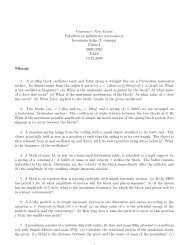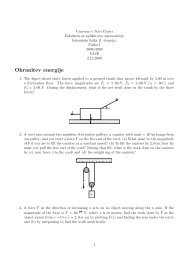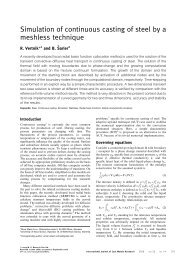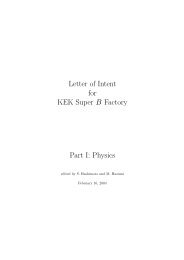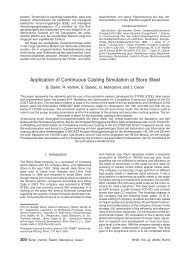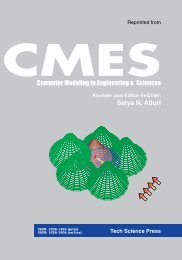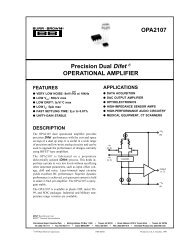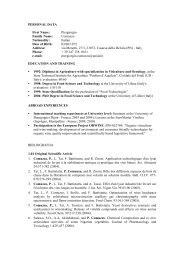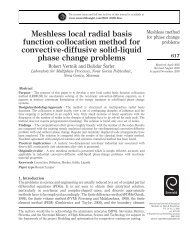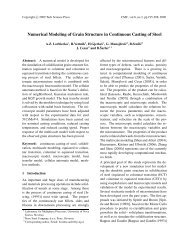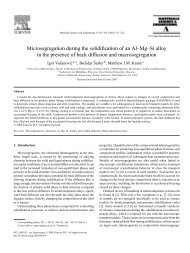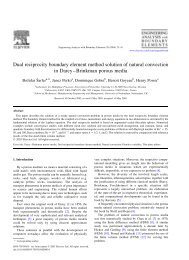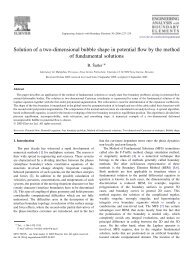Datives: what Galician and Spanish can tell us
Datives: what Galician and Spanish can tell us
Datives: what Galician and Spanish can tell us
Create successful ePaper yourself
Turn your PDF publications into a flip-book with our unique Google optimized e-Paper software.
The puzzle: The dative case appears to show a mixture of properties. Dative resembles structural<br />
case in that it is often realized in grammatical positions where structural cases are also found, e.g.,<br />
subject <strong>and</strong> object positions. Moreover, dative-marked phrases in these positions are often<br />
accessible to the same operations available to structurally case-marked expressions such as<br />
control (1). However, dative-marked phrases under these operations keep the dative case (2).<br />
Then, how should we account for dative case? Two natural options present themselves. We might<br />
treat dative case either as a kind of “hybrid case,” one that somehow combines the properties of<br />
structural <strong>and</strong> inherent cases or as something genuinely different from both – something new.<br />
Data: Although Romance languages like <strong>Spanish</strong> lack inflectional case on full nominals, case is<br />
realized morphologically on clitics. <strong>Spanish</strong> <strong>and</strong> <strong>Galician</strong> are particularly challenging beca<strong>us</strong>e the<br />
range of meanings associated with dative clitics is extremely broad <strong>and</strong> moreover, datives <strong>can</strong> be<br />
argumental (3) <strong>and</strong> non-argumental (4), Ethical dative (4a) <strong>and</strong> Solidarity Allocutive dative (4b).<br />
Previo<strong>us</strong> Analysis: The Applicative Analysis by Cuervo (2003) is a hybrid analysis of datives in<br />
which the properties identified above are combined. <strong>Datives</strong> are distinct objects in the grammar<br />
introduced into the syntax as an “extra participant” through the mediation of an applicative head<br />
(Pylkkänen (2002)) <strong>and</strong>, as a class, are not licensed directly by the verb, <strong>and</strong> are not arguments of<br />
the verb. This applicative head, <strong>can</strong> be projected into different parts of the cla<strong>us</strong>e structure. The<br />
exact interpretation of its dative specifier <strong>can</strong> be derived from the nature of the complement the<br />
ApplP takes, <strong>and</strong> from the nature of the head that takes the ApplP as its complement in turn.<br />
Problems: (i) App is a functional head assigning a thematic role. What then is the notion of<br />
selection appropriate to it? Where, <strong>and</strong> under <strong>what</strong> circumstances, <strong>can</strong> App <strong>and</strong> AppP be<br />
introduced into syntactic structure? Functional heads are introduced by functional selection of the<br />
kind, as T, Neg, asp <strong>and</strong> v. The App does not distribute this way; (ii) as is well-known,<br />
applicatives occur in other languages not only with dative constructions, but also with locatives<br />
<strong>and</strong> instrumentals (Baker 1988) (iii) this analysis also makes the distinction between ‘argumental<br />
<strong>and</strong> non-argumental datives’ obscure. It is not clear <strong>what</strong> it could differentiate argumental from<br />
non-argumental datives, if all are introduced by an Applicative Head. We might speculate that<br />
independent properties of the predicate might license the applicative head for non-argumental<br />
datives <strong>and</strong> make them different from argumental datives, i.e. goal datives,<br />
Proposal: The dative marker is a “concordializing element” allowing phrase bearing it to obtain<br />
case by agreement. Consider the Icel<strong>and</strong>ic nominal. The Nominative case in (5) is “real” on the<br />
nominal head kennigar ‘theories,’ but present simply as agreement on the other elements. The<br />
unvalued source of Nominative case - T- is probing for a valued instance of NOM below it. “On<br />
the way” to the noun head, T’s search encounters “concordial” elements (D, Dem, AP) that<br />
<strong>can</strong>not provide a case value of their own but <strong>can</strong> agree with <strong>what</strong>ever case is ultimately found (6).<br />
Assuming that concordial elements m<strong>us</strong>t bear a case feature, it follows that they m<strong>us</strong>t position<br />
themselves between the probe (T) <strong>and</strong> the goal (N). Larson <strong>and</strong> Harada (2008) propose that this is<br />
also available in vP/VP as well. We have two possibilities for dative: the realization of true<br />
oblique case of the sort checked by a prepositional governor (7a), or it <strong>can</strong> be the realization of a<br />
concordializing element (7b). If we adopt this analysis, first, datives are not associated with a<br />
special functional head like App with specific thematic-semantic contribution. There is th<strong>us</strong> no a<br />
priori expectation that the presence of dative morphology will show consistent correlation with<br />
any bit of interpretation. This is appropriate for <strong>Spanish</strong>, where the range of meanings associated<br />
with dative clitics is extremely broad. Second, absence of the functional licensing head means<br />
that troubling questions of selection do not arise. The relevant phrases are projected into the<br />
argument or non-argument positions, in the <strong>us</strong>ual way, with their final placement being<br />
determined by the conditions on agreement disc<strong>us</strong>sed above. The picture of dative-licensing is a<br />
flexible one: dative phrases are expected anywhere that appropriate probe-goal relations on<br />
structural case are found. They are expected in vP, between v <strong>and</strong> an acc<strong>us</strong>ative (8); they are<br />
expected in TP, between T <strong>and</strong> a nominative subject <strong>and</strong> between a higher functional head X <strong>and</strong><br />
a vocative marked phrase, which I will suggest is also an instance of structural case licensing (8).<br />
1
(1) Ne vidat’ tebe i pokoja [vojdja i sjuda].<br />
not to see you-dat peace going-in-ger here<br />
“You will not have peace if you come in here.” (Control) (R<strong>us</strong>sian)<br />
(2) Borisu prodolzalo byt’ stydno.<br />
Boris.Dat continue.Past.N. be.INF. shameful.N (Raising) (R<strong>us</strong>sian)<br />
‘Boris continued to feel ashamed’ (Perlmutter <strong>and</strong> Moore 2002:637)<br />
(3) a. A S<strong>us</strong>ana i le i g<strong>us</strong>tan/apasionan/en<strong>can</strong>tan las manzanas<br />
To S<strong>us</strong>ana her.cl.Dat like/be passionate about/adore the apples SP<br />
‘S<strong>us</strong>ana likes/is passionate about/adores apples’ (Experiencer)<br />
b. S<strong>us</strong>ana les preparó un té a s<strong>us</strong> amigos<br />
S<strong>us</strong>ana her.cl.Dat. prepared a tea to her friends SP<br />
‘S<strong>us</strong>ana prepared a tea to her friends’ (Benefactive)<br />
c. S<strong>us</strong>ana le m<strong>and</strong>ó una carta a Pablo<br />
S<strong>us</strong>ana her.cl.Dat. sent a letter to Pablo SP<br />
‘S<strong>us</strong>ana sent a letter to Paul’ (Goal)<br />
d. S<strong>us</strong>ana le cortó el pelo a Pablo<br />
S<strong>us</strong>ana her.cl.Dat. cut the hair to Pablo SP<br />
‘S<strong>us</strong>ana cut Pablo’s hair’ (Possessive)<br />
(4) a. Me le arruinaron la vida al niño.<br />
me.cl.dat him.cl.dat ruined the life of the child SP<br />
'They ruined the child life <strong>and</strong> this has an adversative effect on me’ (Affected Dative)<br />
b. As mazás que merquei hoxe estan-che boísimas<br />
the apples that I-bought today are-you. cl.dat very good (<strong>Galician</strong>)<br />
‘The apples that I bought today are very good, you know’ (Solid. Allo. Dat.)<br />
(5) allar pessapr prjár nyju<br />
all.FEM.PL.NOM these.FEM.PL.NOM three.FEM.PL.NOM new.FEM.PL.NOM<br />
kennigar<br />
theories.FEM.PL.NOM<br />
‘all these three new theories’ (Larson <strong>and</strong> Harada 2008)<br />
(6) AGREE SEARCH ENDS<br />
T D Dem AP N-NOM<br />
CHECK<br />
(7) a. P DP-DAT<br />
AGREE<br />
b, Probe DP-DAT XP<br />
(8) a. AGREE<br />
v DP-DAT DP-ACC<br />
b. AGREE<br />
T DP-DAT DP-NOM<br />
c. AGREE<br />
X DP-DAT DP-VOC<br />
Partial References: BAKER, M. 1988. Incorporation: A theory of grammatical function<br />
changing. Chicago: University of Chicago Press. CUERVO, M.C. 2003. <strong>Datives</strong> at Large. PhD<br />
Dissertation. MIT. LARSON, R. & N. HARADA. 2008. <strong>Datives</strong> in Japanese. Unpublished<br />
man<strong>us</strong>cript. Stony Brook.<br />
2



